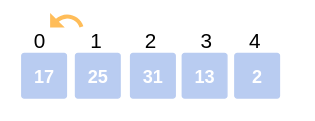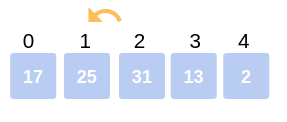Insertion sort is the sorting mechanism where the sorted array is built having one item at a time. The array elements are compared with each other sequentially and then arranged simultaneously in some particular order. The analogy can be understood from the style we arrange a deck of cards. This sort works on the principle of inserting an element at a particular position, hence the name Insertion Sort.
Quick Navigation
Insertion Sort works as follows:
- The first step involves the comparison of the element in question with its adjacent element.
- And if at every comparison reveals that the element in question can be inserted at a particular position, then space is created for it by shifting the other elements one position to the right and inserting the element at the suitable position.
- The above procedure is repeated until all the element in the array is at their apt position.
Let us now understand working with the following example:
Consider the following array: 25, 17, 31, 13, 2
First Iteration: Compare 25 with 17. The comparison shows 17< 25. Hence swap 17 and 25.
The array now looks like:
17, 25, 31, 13, 2
First Iteration
Second Iteration: Begin with the second element (25), but it was already swapped on for the correct position, so we move ahead to the next element.
Now hold on to the third element (31) and compare with the ones preceding it.
Since 31> 25, no swapping takes place.
Also, 31> 17, no swapping takes place and 31 remains at its position.
The array after the Second iteration looks like:
17, 25, 31, 13, 2
Second Iteration
Third Iteration: Start the following Iteration with the fourth element (13), and compare it with its preceding elements.
Since 13< 31, we swap the two.
Array now becomes: 17, 25, 13, 31, 2.
But there still exist elements that we haven’t yet compared with 13. Now the comparison takes place between 25 and 13. Since, 13 < 25, we swap the two.
The array becomes 17, 13, 25, 31, 2.
The last comparison for the iteration is now between 17 and 13. Since 13 < 17, we swap the two.
The array now becomes 13, 17, 25, 31, 2.
Third Iteration

Fourth Iteration: The last iteration calls for the comparison of the last element (2), with all the preceding elements and make the appropriate swapping between elements.
Since, 2< 31. Swap 2 and 31.
Array now becomes: 13, 17, 25, 2, 31.
Compare 2 with 25, 17, 13.
Since, 2< 25. Swap 25 and 2.
13, 17, 2, 25, 31.
Compare 2 with 17 and 13.
Since, 2<17. Swap 2 and 17.
Array now becomes:
13, 2, 17, 25, 31.
The last comparison for the Iteration is to compare 2 with 13.
Since 2< 13. Swap 2 and 13.
The array now becomes:
2, 13, 17, 25, 31.
This is the final array after all the corresponding iterations and swapping of elements.
Fourth Iteration
Pseudocode
INSERTION-SORT(A)
for i = 1 to n
key ← A [i]
j ← i – 1
while j > = 0 and A[j] > key
A[j+1] ← A[j]
j ← j – 1
End while
A[j+1] ← key
End for Implementation:
Following are C, C++, Java and Python implementations of Insertion Sort.
Insertion sort Implementation in C:
#include <stdio.h>
#include <stdbool.h>
#define MAX 7 //defining size of our array
int intArray[MAX] = {4,6,3,2,1,9,7};
void printline(int count) {
int i;
for(i = 0;i < count-1;i++) {
printf("=");
}
printf("=\n");
}
void display() {
int i;
printf("[");
// navigate through all items
for(i = 0;i < MAX;i++) {
printf("%d ",intArray[i]);
}
printf("]\n");
}
void insertionSort() {
int valueToInsert;
int holePosition;
int i;
// loop through all numbers
for(i = 1; i < MAX; i++) {
// select a value to be inserted.
valueToInsert = intArray[i];
// select the hole position where number is to be inserted
holePosition = i;
// check if previous no. is larger than value to be inserted
while (holePosition > 0 && intArray[holePosition-1] > valueToInsert) {
intArray[holePosition] = intArray[holePosition-1];
holePosition--;
printf(" item moved : %d\n" , intArray[holePosition]);
}
if(holePosition != i) {
printf(" item inserted : %d, at position : %d\n" , valueToInsert,holePosition);
// insert the number at current hole
intArray[holePosition] = valueToInsert;
}
printf("Iteration %d#:",i);
display();
}
}
void main() {
printf("Input Array: ");
display();
printline(50);
insertionSort();
printf("Output Array: ");
display();
printline(50);
}Insertion sort Implementation in C++:
#include <stdlib.h>
#include <iostream>
using namespace std;
//member functions declaration
void insertionSort(int arr[], int length);
void printArray(int array[], int size);
// main function
int main()
{
int array[6] = {5, 1, 6, 2, 4, 3};
// calling insertion sort function to sort the array
insertionSort(array, 6);
return 0;
}
void insertionSort(int arr[], int length)
{
int i, j, key;
for (i = 1; i < length; i++)
{
key = arr[i];
j = i-1;
while (j >= 0 && arr[j] >key)
{
arr[j+1] = arr[j];
j--;
}
arr[j +1] = key;
}
cout << "Sorted Array: ";
// print the sorted array
printArray(arr, length);
}
// function to print the given array
void printArray(int array[], int size)
{
int j;
for (j = 0; j < size; j++)
{
cout <<" "<< array[j];
}
cout << endl;
}// Java program for implementation of Insertion Sort
public class InsertionSort
{
/*Function to sort array using insertion sort*/
void sort(int arr[])
{
int n = arr.length;
for (int i=1; i<n; ++i)
{
int key = arr[i];
int j = i-1;
/* Move elements of arr[0..i-1], that are
greater than key, to one position ahead
of their current position */
while (j>=0 && arr[j] > key)
{
arr[j+1] = arr[j];
j = j-1;
}
arr[j+1] = key;
}
}
/* A utility function to print array of size n*/
static void printArray(int arr[])
{
int n = arr.length;
for (int i=0; i<n; ++i)
System.out.print(arr[i] + " ");
System.out.println();
}
// Driver method
public static void main(String args[])
{
int arr[] = {12, 11, 13, 5, 6};
InsertionSort ob = new InsertionSort();
ob.sort(arr);
printArray(arr);
}
}Insertion sort Implementation in Python:
# Function to do insertion sort
def insertionSort(arr):
# Traverse through 1 to len(arr)
for i in range(1, len(arr)):
key = arr[i]
# Move elements of arr[0..i-1], that are
# greater than key, to one position ahead
# of their current position
j = i-1
while j >=0 and key < arr[j] :
arr[j+1] = arr[j]
j -= 1
arr[j+1] = key
# Driver code to test above
arr = [12, 11, 13, 5, 6]
insertionSort(arr)
print ("Sorted array is:")
for i in range(len(arr)):
print arr[i]Time Complexity Analysis:
Even though insertion sort is efficient, still, if we provide an already sorted array to the insertion sort algorithm, it will still execute the outer for loop, thereby requiring n steps to sort an already sorted array of n elements, which makes its best case time complexity a linear function of n.
Wherein for an unsorted array, it takes for an element to compare with all the other elements which mean every n element compared with all other n elements. Thus, making it for n x n, i.e., n2 comparisons. One can also take a look at other sorting algorithms such as Merge sort, Quick Sort, Selection Sort, etc. and understand their complexities.
Worst Case Time Complexity [ Big-O ]: O(n2)
Best Case Time Complexity [Big-omega]: O(n)
Average Time Complexity [Big-theta]: O(n2)

















 Video Courses
Video Courses












